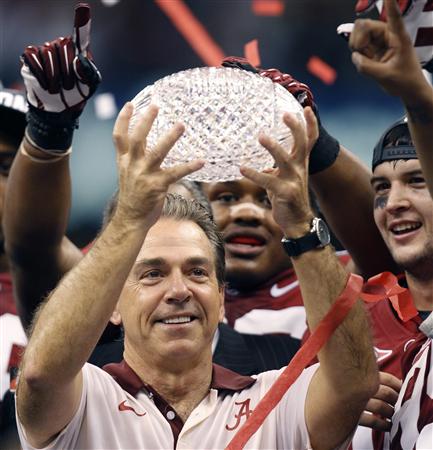That napkin: It’s in the Alabama Football Museum today, under glass. The stats are barely legible, but the meaning is crystal clear. Worn by time and faded by history, that simple piece of paper holds more weight in Alabama football lore than some championship banners. What began as a quick scribble of ideas, a seemingly unremarkable moment in the chaos of college football, has transformed into a legendary artifact. The napkin, tucked now beneath glass and reverent lighting, is a relic that speaks volumes—not only about a program but about belief, vision, and destiny.
The story behind the napkin goes back to a crossroads moment in Alabama football history. It was a time when the Tide were powerful but uncertain, rich with tradition yet searching for clarity. The team, the fans, and the university itself were longing for a new era of dominance—a resurrection of the standard that Bear Bryant had set decades before. It wasn’t that Alabama was irrelevant; it was that they were no longer feared. For a program that prided itself on setting the bar for excellence in college football, that was unacceptable.
Enter a coach with a plan. Not just a plan for a single season, but a vision for a dynasty. When Nick Saban came to Alabama in 2007, his arrival was met with a mix of fanfare, skepticism, and hope. He had already proven himself at LSU and in the NFL with the Miami Dolphins, but taking the reins of Alabama was a different kind of beast. It was stepping into the heart of a state’s identity, into a culture where college football wasn’t just a sport—it was a lifeblood. And in that culture, results weren’t just expected. They were demanded.
The napkin moment didn’t happen on national television. There were no flashing cameras, no studio lights, no formal announcements. It happened in a quiet moment, over a lunch meeting, where football minds came together to draw up not just a strategy for a game, but a blueprint for building an empire. It was scratched out quickly, almost hurriedly, as ideas flowed and possibilities took shape. Defensive schemes, recruiting targets, game tempo, special teams emphasis—all jotted down like a grocery list. But what made the napkin special wasn’t its content—it was its conviction.
That napkin became a symbol of how greatness often starts in simplicity. Just as J.K. Rowling wrote the first notes of Harry Potter on a napkin in a café, or how Steve Jobs sketched designs for Apple products on restaurant scraps, this torn piece of paper became Alabama’s declaration of intent. It said: We’re going to build something great here. Not just win games. Not just make bowls. We’re going to make history. It was as if the football gods themselves nodded in approval when that napkin hit the table.
Today, as fans walk through the Alabama Football Museum in Tuscaloosa, they linger at the display where the napkin sits. Some lean in, squinting to try and decipher the faded ink, trying to catch a glimpse of what genius might look like in its earliest form. Others simply stand in silence, reflecting on everything that napkin set in motion. From the national championships to the Heisman winners, from the draft picks to the undefeated seasons—every great moment of the modern Alabama era traces back, in some way, to that moment.
It’s not that the napkin caused the success. The napkin didn’t lift weights, or study film, or make tackles. But it encapsulates what makes Alabama football what it is—attention to detail, relentless vision, and belief in process. That word—process—has become gospel in Tuscaloosa. It’s printed on T-shirts, spoken in press conferences, and etched into the minds of every player who walks into Bryant-Denny Stadium. And the first true manifestation of that process was that napkin.
What also makes the napkin remarkable is what it tells us about leadership. Nick Saban didn’t just bring Xs and Os to Alabama; he brought culture. He brought discipline. He brought a way of thinking that filtered down from the coaches to the freshmen walk-ons. The napkin wasn’t just a play sheet—it was a mission statement. It was a declaration that Alabama would no longer measure success by comparison to others, but by its own uncompromising standard. And it worked.
Since that time, Alabama has experienced an era of dominance rarely seen in college football. Multiple national championships, countless All-Americans, record-breaking NFL draft classes—each a reflection of the vision laid out on that napkin. Yet despite the trophies and accolades, it’s that fragile piece of paper that continues to draw awe. Because it reminds us that greatness is planned. It reminds us that every giant leap begins with a small step—or in this case, a scribble.
The reverence for the napkin isn’t just about Alabama, either. It speaks to something more universal in sports—and in life. The idea that behind every towering achievement lies a moment of quiet intention. That even the biggest dreams begin with a pen, a moment of clarity, and a willingness to believe. Coaches from across the country visit Tuscaloosa and stop at that glass case not out of envy, but out of inspiration. It tells them, “This is how it starts.” Fans, too, find in it a reminder that dynasties aren’t born out of luck, but out of preparation.
Of course, there are always skeptics. Some argue that the myth of the napkin has been exaggerated over time. That what was once a casual document has been retrofitted into legend. But that’s the thing about symbols—they don’t need to be perfect to be powerful. Whether or not the napkin contains the exact moment when Alabama football was reborn isn’t the point. What matters is that it represents the spirit of transformation. It captures the moment when Alabama stopped looking backward and started building forward.
There’s also something poetic about the napkin’s fragility. How something so temporary could lead to something so enduring. In an age of tablets and digital playbooks, the idea of a dynasty beginning on a paper napkin feels almost romantic. It’s a reminder that while technology evolves, the fundamentals of leadership and vision remain timeless. That greatness often starts with the boldness to say, “Let’s do this,” no matter the medium.
Even as Nick Saban’s career winds down and the next generation of Alabama coaches and players prepare to carry the mantle, that napkin will remain. It will sit there, under glass, in the climate-controlled quiet of the museum, long after the cleats have been hung and the confetti has settled. And it will continue to whisper to anyone who stops to look: This is what belief looks like. This is what it means to plan your future before the world sees it.
It may not be the most glamorous item in the museum. It doesn’t shimmer like the trophies or gleam like the game-worn helmets. But ask any true Alabama fan what piece of the exhibit resonates most, and you’ll often hear the same answer: That napkin. Because in that ink-stained square lies the spark of a revolution, the start of a journey, and the beginning of a football renaissance.
In the end, that napkin is a lot like Alabama football itself—rooted in tradition, driven by intention, and committed to excellence. It doesn’t need to shout to be heard. Its very presence says enough. For anyone who’s ever doubted the power of vision, or questioned whether greatness can truly be planned, a visit to that museum answers it all. You won’t need to read the writing to understand. You’ll feel it. Just look through the glass, and you’ll see it for yourself. That napkin changed everything.



